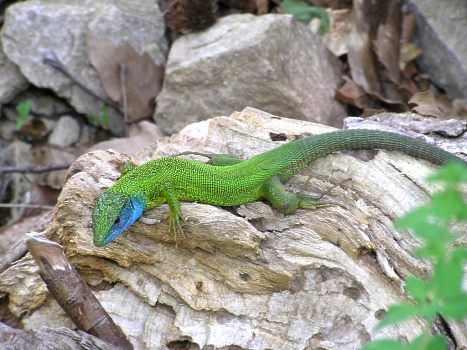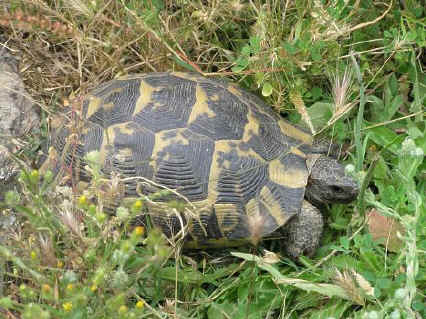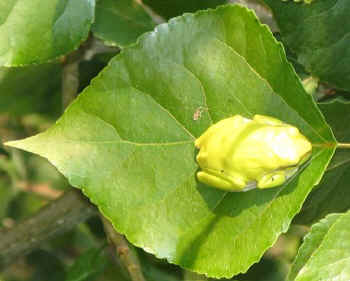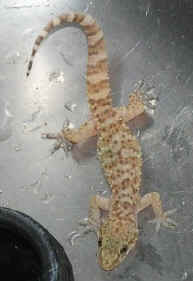|
Description / Habitats / Flora / Vertebrates / Insects / Invertebrates / What's that Bug? Home / Nestos Delta / Bibliography / About this site / Links / Contents / Galleries ____________________________________________________________________________ |
|
______________________________________________________________________ REPTILES & AMPHIBIANS
True snakes are regularly seen in old olive groves or in wild habitats (for example, amongst maquis and in the pine forests), but they quickly dash for cover and rarely give views good enough for identification. I see snakes almost daily during my visits but rarely for long enough to identify them - though presumably such fleeting glimpses are enough for experienced herpetologists. Although the Montpellier snake can bite if provoked, this is only likely if they are picked up and even then any swelling, stiffness or discomfort will pass in a few hours. This is not the case with the nose-horned viper, which is one of the most venomous snakes in Europe. It hisses loudly when disturbed and can become aggressive if provoked so it is wise to leave this species alone if accidentally encountered. These two species excepted, the remaining five snake species on Thásos are entirely harmless to man.
Eastern Montpellier's snake Systematic accounts of the herptile fauna of Greece have been published for over a century (e.g. Werner 1938) and records for Thásos (and other Aegean islands) were summarised by Ondrias (1968) and Chondropoulos (1986, 1989). Following Yeomans’ (1990) account of the species seen during brief visits in 1989 and 1990, Clark (1993) collated the first review of the herpetofauna of Thásos. This paper was later updated and revised (Clark 1999), incorporating discussion of the previous species’ lists and correcting some earlier errors of identification. Clark (1999) regarded the Thásos fauna as comprising nineteen species, dismissing the record of the four-lined snake by Grüber (1979) and the records of Balkan wall lizard by Yeomans (1990) and others. My own observation of two full-grown four-lined snakes basking on an apartment wall at Makriammos in 1982 lend support to Grüber and suggest that the four-lined snake should be retained on the Thásos checklist. A distinct sub-species of the Balkan wall lizard, P. t. thasopulae (Kattinger), occurs on the islet of Thassopoula between Thásos and Keramoti. A further addition to the island fauna is the leopard snake, recorded from Kazaviti in 1994 by Dr T. Schultze-Westrum (pers. comm.). The presence of this species was confirmed in 1996 by Cattaneo (2001), who also confirmed Dahl's whip snake on Thásos (a species which had been reported by several previous authors but omitted by Clark). Cattaneo (2001) recorded eighteen species on the island in May 1997, providing the most thorough account of the herpetile fauna of Thásos published to date, although he did not find four species which have been reliably recorded in the past. Clark (1999) drew attention to the possibility of the presence of the European pond terrapin Emys orbicularis on Thásos, in view of the fact that it had recently been discovered on Samothraki, and it had been included in supporting documentation for the Natura 2000 site Oros Ypsari without further details. Emys was reliably recorded from the island by Yann Horstink in July 2007 near Prinos (a single individual along with c20 Mauremys in a small area of open water in a reed-filled ditch) and Lance Chilton photographed two Emys there in May 2012. The island checklist thus contains 23 species (six amphibians and seventeen reptiles). A further three species (Erhard's wall lizard Podarcis erhardii, common wall lizard P. muralis and eyed skink Chlacides ocellatus) have been reported in the literature (see Cattaneo 2001 for references) but are considered to represent erroneous identifications, whilst the cat snake Telescopus fallax is named in supporting documentation for the Natura 2000 site Oros Ypsari (which also lists Podarcis muralis) without further evidence. In addition, Hingley (1996) reported Balkan Wall lizard P. tauricus from Hrisi Amoudia on Thásos in October 1995 and I photographed a specimen near Kastro in May 2016 that appears to be this species. There are now several reports of P. tauricus from Thásos but, given the difficulties that surround identification of lizards on the island, it seems wise to wait for expert confirmation before admitting the species to the island list. Mention should be made of the confusion surrounding the identity of the marsh frogs on Thásos. Bioacoustic studies in the late 1980s and early 1990s (Schneider et al. 1993) demonstrated that Rana ridibunda should be taxonomically split and although this proposal met with some initial doubt, those findings have been reinforced by genetic analysis to show that R. balcanica and R. ridibunda are indeed reproductively isolated (Sinsch & Eblenkamp 1994). The Greek marsh frog R. balcanica (now known as Pelophylax kurtmuelleri) has been recorded from Thásos (see amphibiaweb) but as R. ridibunda is also known from the nearby mainland along the Nestos river the possibility that it also occurs on the island cannot be ruled out.
All European species are beautifully illustrated in Arnold, Burton & Overton (1978). Unfortunately the identification of many species is not easy and it should be borne in mind that colour patterns are variable in many cases and that juvenile reptiles are often a different colour from the adults. There is a useful website with many excellent photographs at Herpetofauna Of.Greece and Valakos et al. (2008) have published a review of the entire Greek fauna.
CHECKLIST (nomenclature from Speybroeck, J. & Crochet, P.-A. 2007) Common toad Bufo bufo (Daudin) Green toad Epidalea viridis (Laurenti) Tree frog Hyla arborea (Linnaeus) Agile frog Rana dalmatina Fitzinger Stream frog Rana graeca Boulenger Greek Marsh frog Pelophylax kurtmuelleri (Gayda) European pond terrapin Emys orbicularis Balkan terrapin Mauremys rivulata (Valenciennes) Spur-thighed tortoise Testuda graeca (Linnaeus) Turkish gecko Hemidactylus turcicus (Linnaeus) Naked-fingered (or Kotschyi's) gecko Mediodactylus kotschyi (Steindachner) Slow worm Anguis fragilis Linnaeus Glass snake (European glass lizard) Pseudopus apodus (Pallas) Eastern Green lizard Lacerta viridis (Laurenti) Snake-eyed lizard Ophisops elegans Ménétries Worm snake Typhlops vermicularis Merem Nose horned viper Vipera ammodytes (Linnaeus) Large whip snake Dolicophis caspius (Gmelin) Dahl's whip snake Platyceps najadum (Eichwald) Eastern Montpellier snake Malpolon insignitus (Geoffroy Saint-Hilaire) Four-lined snake Elaphe quatuorlineata (Lacépčde) Leopard snake Zamenis situla (Linnaeus) Grass snake Natrix natrix (Linnaeus)
Common Tree-frog (©
S.
Watson)
Note: Dr Thomas Schultze-Westrum's website lists six reptile species occurring around Kazaviti. Two of these would be additions to the Thásos fauna, but are more likely to represent a degree of confusion over their taxonomy. Greek tortoise Testudo hermanni has not been reported by other researchers, who state that the tortoise species on Thásos is Spur-thighed tortoise T. graeca; Western green lizard Lacerta bilineata recorded for Kazaviti is presumably in error for Eastern green Lizard Lacerta viridis
REFERENCES
Arnold, E.N., Burton, J.A. & Overton, D.W. 1978. A field guide to the reptiles and amphibians of Britain and Europe. Collins, London. Cattaneo, A. 2001. L'erpetofauna delle isole egee di Thassos, Samothraki e Lemnos. Boll. Mus. Civ. Stor. Nat. Venezia, 52: 155-181. Chondropoulos, B.P. 1986. A checklist of the Greek reptiles. 1. The lizards. Amphibia-Reptilia, 7: 217-235. Chondropoulos, B.P. 1989. A checklist of the Greek reptiles. 2. The snakes. Herpetozoa, 2: 3-36. Clark, R.J. 1993. The herpetofauna of the Greek island of Thassos. The Herptile, 18: 183-187. Clark, R.J. 1999. Herpetofauna of Thassos, North Aegean Sea, Greece. British Herpetological Society Bulletin, 66:14-18. Grüber, U. 1979. Patterns and relationships of Aegean snakes. Biologica Gallo-Hellenica, 8: 345-348. Hingley., K., 1996. Thassos. Reptilia (English edition). 3: 54-56 Horstink, Y. 2007. Herpetolofauna Thassos, Griekenland. http://www.ravon.nl/Forum/tabid/67/aftopicid/1034/afnav/NEXT/language/nl-NL/Default.aspx Ondrias, J.C. 1968. Liste des Amphibiens et des Reptiles de Gréce. Biologica Gallo-Hellenica, 1: 111-135.
Schneider, H., U. Sinsch & T. S. Sofianidou. 1993. The water frogs
of Greece : Bioacoustic evidence for a new species. Z. zool.
Syst. Evolutforsch., 31: 47-63. Speybroeck, J. & Crochet, P.-A. 2007. Species list for the European herpetofauna - a tentative update. Podarcis 8: 8-34. Valakos, E.D., Pafilis, P., Sotiropoulos, K., Lymberakis, P., Maragou, P. & Foufopoulos, J. 2008. The amphibians and reptiles of Greece. Chimaira, Frankfurt, 463 pp. Werner, F. 1938. Die Amphibien und Reptilien Griechenlands. Zoologica, 35: 1-117. Yeomans, L. 1990. "Pouen ay efiri", or reptile spotting on Thassos. The Herptile, 15: 6-8. |
||||||||||||

.jpg)

.jpg)
 Even casual tourists to Thásos, as elsewhere in the Aegean, are fascinated
by the brightly coloured Green Lizards Lacerta viridis (often with a
striking blue throat) which are widespread and not uncommon throughout the
island. Other reptiles and amphibians are less frequently encountered but an
observant naturalist can expect to see several species during the course of a
visit, especially in early summer. Amongst lowland scrub, such as neglected
olive groves, or on the sand dunes at Chrissi Ammoudi there is always a chance
of seeing spur-thighed tortoise or of flushing the remarkable glass snake. This
latter species is actually a legless lizard which grows up to 120 centimetres in
length.
Even casual tourists to Thásos, as elsewhere in the Aegean, are fascinated
by the brightly coloured Green Lizards Lacerta viridis (often with a
striking blue throat) which are widespread and not uncommon throughout the
island. Other reptiles and amphibians are less frequently encountered but an
observant naturalist can expect to see several species during the course of a
visit, especially in early summer. Amongst lowland scrub, such as neglected
olive groves, or on the sand dunes at Chrissi Ammoudi there is always a chance
of seeing spur-thighed tortoise or of flushing the remarkable glass snake. This
latter species is actually a legless lizard which grows up to 120 centimetres in
length.
 Five species occurring on Thásos are included on Annex II of the EU Habitats &
Species Directive - spur-thighed tortoise Testudo
graeca, Balkan terrapin Mauremys
rivulata (=caspica), European pond terrapin Emys orbicularis,
four-lined snake Elaphe
quatuorlineata and leopard snake Zemanis
situla.
Five species occurring on Thásos are included on Annex II of the EU Habitats &
Species Directive - spur-thighed tortoise Testudo
graeca, Balkan terrapin Mauremys
rivulata (=caspica), European pond terrapin Emys orbicularis,
four-lined snake Elaphe
quatuorlineata and leopard snake Zemanis
situla. 
 Turkish gecko
Turkish gecko